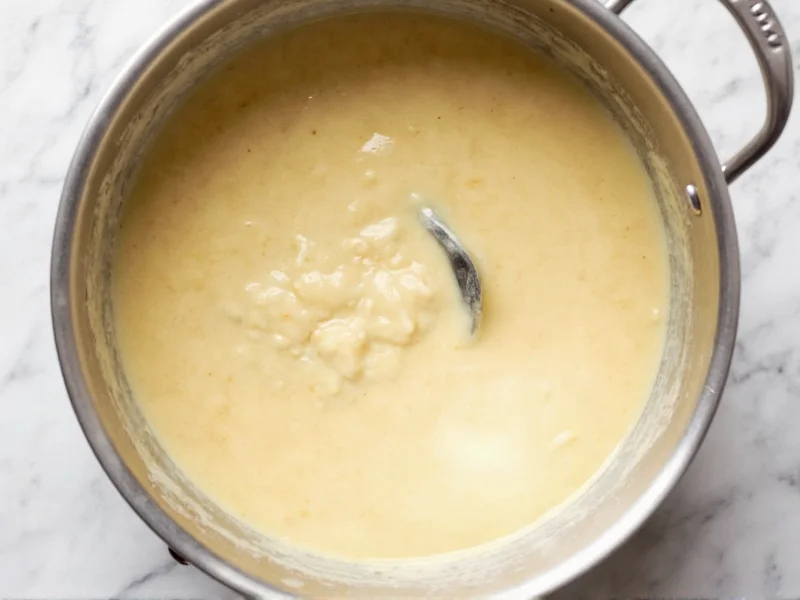Alfredo sauce that's too thin can ruin your pasta dish, but fixing it is simpler than you might think. Understanding why your sauce thinned in the first place helps you choose the best thickening method for your situation. Whether you're dealing with sauce that separated during cooking or became watery when combined with pasta, these professional techniques will rescue your dish without compromising flavor.
Why Alfredo Sauce Gets Thin: Common Causes
Before reaching for thickening agents, identify why your alfredo sauce thinned. Common culprits include:
- Excess moisture from pasta - Adding sauce to improperly drained pasta introduces too much water
- Temperature issues - High heat can cause the emulsion to break
- Ingredient ratios - Too much cream or milk relative to cheese and butter
- Low-quality cheese - Pre-grated cheeses contain anti-caking agents that prevent proper melting
- Overdilution - Adding too much pasta water when finishing the dish
Knowing the cause helps you select the most appropriate thickening method and prevent recurrence in future preparations.
Five Reliable Methods to Thicken Alfredo Sauce
1. Cornstarch Slurry Technique
This is the fastest solution when you need immediate results. For every cup of thin alfredo sauce:
- Mix 1 tablespoon cornstarch with 1 tablespoon cold water until smooth
- Remove sauce from heat
- Whisk in the slurry gradually
- Return to low heat and cook for 2-3 minutes until thickened
Pro tip: Never add dry cornstarch directly to hot sauce - it will clump. Always create a slurry first. This method works well for how to thicken alfredo sauce without flour when you need a gluten-free solution.
2. Quick Roux Method
If you have a few extra minutes, a light roux provides excellent thickening without altering flavor:
- Melt 1 tablespoon butter in a separate pan
- Whisk in 1 tablespoon all-purpose flour
- Cook for 1-2 minutes until bubbly but not browned
- Gradually whisk in ¼ cup of your thin alfredo sauce
- Once smooth, combine with remaining sauce
| Thickening Method | Time Required | Flavor Impact | Best For |
|---|---|---|---|
| Cornstarch Slurry | 3-5 minutes | Minimal | Immediate rescue of separated sauce |
| Quick Roux | 5-7 minutes | Slight richness | When starting sauce from scratch |
| Reduction | 8-12 minutes | Enhanced flavor | Sauces only slightly too thin |
| Cheese Addition | 2-3 minutes | More cheesy | Maintaining authentic flavor profile |
3. Simmering and Reduction
The most authentic approach requires patience but preserves flavor integrity:
- Bring sauce to a gentle simmer over medium-low heat
- Maintain a slow bubble for 8-12 minutes
- Stir frequently to prevent scorching
- Remove from heat when it coats the back of a spoon
This traditional method concentrates flavors while thickening, making it ideal when you have time to perfect your sauce. It's particularly effective for fixing alfredo sauce that's slightly too thin but otherwise well-emulsified.
4. Additional Cheese Incorporation
When wondering how to thicken alfredo sauce without altering texture, more cheese often provides the perfect solution:
- Remove sauce from heat source
- Gradually whisk in ¼-½ cup freshly grated parmesan
- Allow cheese to melt completely before adding more
- Stop when desired consistency is reached
Freshly grated cheese melts better than pre-grated varieties, which contain starches that can make sauce grainy. This method works exceptionally well for restaurant-style alfredo sauce thickening when maintaining authentic texture is crucial.
5. Cream Cheese Alternative
For a richer, more stable emulsion:
- Blend 2-3 tablespoons softened cream cheese with 2 tablespoons warm sauce
- Whisk this mixture back into the main sauce
- Heat gently until fully incorporated
Cream cheese adds stability that prevents future separation, making it ideal for meal prep situations where you need to know how to thicken alfredo sauce for leftovers. The slight tang balances well with the richness of traditional alfredo.
Preventing Thin Alfredo Sauce in Future Preparations
Professional chefs avoid thin sauce through these techniques:
- Reserve pasta water - Use only ¼ cup starchy water when finishing pasta
- Proper cheese selection - Always use freshly grated parmesan, never pre-grated
- Temperature control - Keep heat at medium-low to prevent emulsion breakdown
- Ingredient ratios - Maintain 1:1 butter to cheese ratio with minimal cream
- Emulsification technique - Gradually incorporate liquids while whisking constantly
Troubleshooting Thickening Problems
Sauce Became Too Thick
If your sauce thickens beyond desired consistency:
- Add small amounts of warm cream or reserved pasta water
- Whisk vigorously while adding liquid
- Add 1-2 teaspoons at a time until proper texture returns
Sauce Separated During Thickening
If your sauce breaks while thickening:
- Remove from heat immediately
- Place ¼ cup of warm cream or milk in separate bowl
- Very slowly whisk the broken sauce into the cream
- Return to low heat while continuing to whisk
This re-emulsifies the sauce. For persistent separation issues, an immersion blender can help restore smoothness.











 浙公网安备
33010002000092号
浙公网安备
33010002000092号 浙B2-20120091-4
浙B2-20120091-4